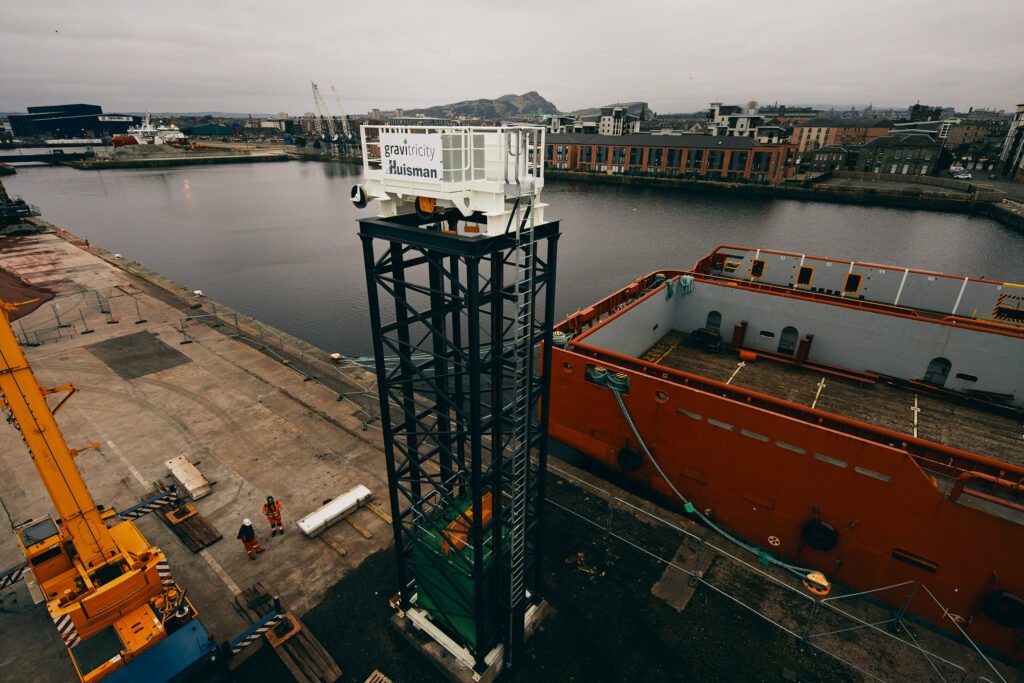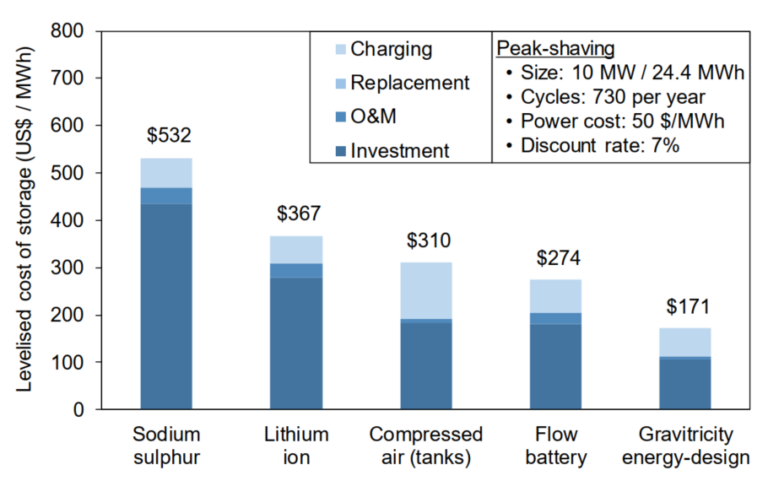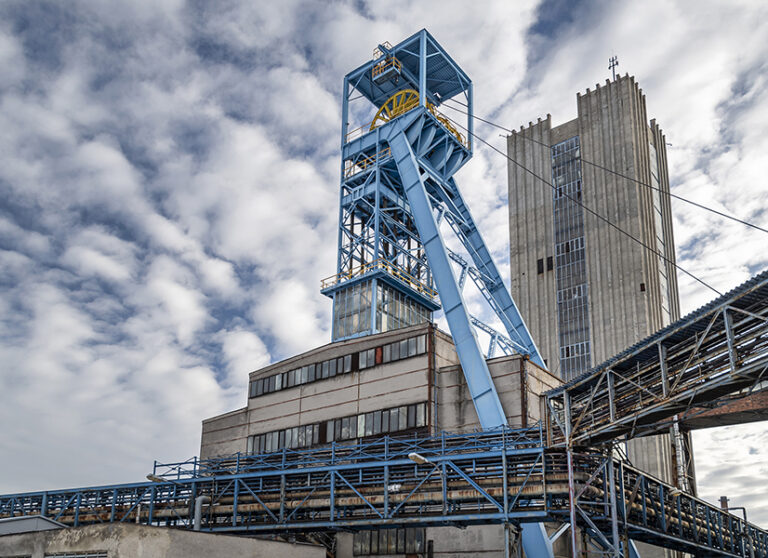Before we can transition to 100% renewable electricity, we need to solve the challenge of energy storage. Could gravity batteries, an elegant and cutting-edge technology that harnesses one of nature’s fundamental forces, help us towards this vital goal?
One of the biggest obstacles to the UK transitioning to 100% green energy is that renewable sources don’t always generate electricity when we want them to.
While we can burn fossil fuels to produce electricity at near enough the flick of a switch, most renewable sources are innately intermittent. There’s no guarantee that the sun’s going to shine or the wind’s going to blow when everyone’s sitting down for their afternoon cup of tea or turning on their TVs to watch a big football match.
The solution to this predicament is storage – capturing green energy when there’s too much and releasing it into the grid when there’s too little. But storing energy is difficult, as anyone who’s ever had their phone die on them at an inopportune moment will attest.
Grid-scale storage technologies – the kind needed to hasten our switch to renewables – are still some years away from being able to accommodate the requirements of our electrically-ravenous society.
The technology is evolving quickly, though, thanks in large part to the determined work of a handful of companies dotted around the UK.
We spoke to one of these companies, Edinburgh-based Gravitricity, on a recent episode of GrantTree’s innovation podcast, What Comes Next?. Gravitricity is working on an ingenious technology that stores electricity as gravitational potential energy by hoisting up a large weight.
This may sound like a simple idea, but don’t let its elegance fool you. Gravitricity’s gravity battery could play a huge role in our efforts to abandon fossil fuels for good and limit the amount of further damage we inflict on nature.

How do gravity batteries work?
All batteries, be they the lithium-ion ingot in your smartphone or the hulking lead-acid powerhouse in your car, work in the same way: they store electrical energy as a form of potential energy.
In the case of gravity batteries, the electrical energy is stored as gravitational potential energy. That is, the energy an object would release should it be allowed to fall towards the earth’s centre.
Gravity batteries make this conversion by using excess electricity generated by a renewable energy source to lift up a heavy weight. In essence, Gravitricity’s system works like an elevator, only instead of a cosy compartment filled with muzak, the object being lifted is a solid piece of densely-packed material. The denser the material, the more energy the system can store.
When the battery needs to release energy, the weight is slowly lowered with help from gravity. As the weight descends, the reinforced cables connected to the weight drive a series of motors that generate electricity.
When fully operational, Gravitricity expects each battery to release between 1 megawatt (MW) and 20MW at peak power and output energy for up to eight hours. According to Gravitricity’s website, a 20MW power system “could power 63,000 homes for every hour that it discharges”.
The fact that Gravitricity’s batteries can discharge energy for up to 8 hours makes them particularly well-suited to storing solar power. The battery would absorb excess solar energy during the day when the sun is up and release it throughout the night when it’s dark.
However, these characteristics also mean that gravity batteries are poorly suited to housing wind power, which is far less predictable.

Gravity batteries vs the alternatives
It’s clear that the UK’s energy storage capacity will be made up of a number of different kinds of systems rather than any one single technology. As Gravitricity’s managing director, Charlie Blair, told What Comes Next? “there is lots of space for lots of different flexibility providers.”
That said, gravity batteries appear to offer a number of advantages over other forms of energy storage. For example, Blair explained that Gravitricity’s system could last 10 times longer than a large lithium-ion battery and would not have any cycle limits, meaning the company’s gravity battery can effectively be recharged an unlimited number of times, assuming it is properly maintained.
Because gravity batteries have a much longer lifespan, they may also be far better for the environment. Working with a team from Edinburgh University, Gravitricity found that gravity-based systems had a much smaller carbon footprint than lithium-ion batteries. These findings are based on a gravitational system lasting 25 years, but given that Gravitricity is hoping that each unit will last closer to half a century, the carbon savings could be far greater.
Gravity batteries aren’t just better for the environment than other solutions. They also have the potential to be much more cost-effective.
According to an independent study by Imperial College London, Gravitricity’s theoretical system could store energy at a cost of just $171 per megawatt-hour (MWh). That would make it significantly cheaper than other established methods of energy storage, such as flow batteries ($274 per MWh), compressed air tanks ($310), and lithium-ion batteries ($367).
Blair does concede that we should take this analysis with a pinch of salt. “On the cost, it’s difficult to get a perfect answer. It’s very difficult to get simple, clear answers on how much lithium batteries cost, to be honest. But on an upfront cost basis, we’re targeting being a similar sort of cost. But on a lifetime basis…we’re targeting being very much cheaper.”

Reclaiming old mines
Another core advantage of Gravitricity’s system is that it can be deployed underground, meaning it has a significantly smaller surface footprint than some of the other storage solutions on the table. As Blair explained, Gravitricity’s battery “does require some space but nothing like as much space as a 100 MW battery on the surface which…need to be spread out because of fire and explosion risk.”
Initially, Blair proposes installing gravity batteries in disused mine shafts, which already offer the required subterranean space. The idea of recuperating sites of fossil fuel production as depots for green energy is not only eminently practical; it’s pleasingly poetic. It also embodies the values of just transition, which preaches principles and practices for transforming our extractive economy into a regenerative one.
Gravity batteries that need to be installed in or near cities could be buried in purpose-dug underground cavities, or even, as Blair told What Comes Next?, “built into the foundations of a skyscraper.” Excitingly, these subterranean complexes could also be equipped to house other forms of energy storage like solar heat, which would be used to warm homes during the winter instead of natural gas.

What’s next for gravity batteries?
Gravity batteries are a promising technology that could help us sever our long-standing ties to fossil fuels. But when can we expect these systems to come online?
Charlie Blair and the whole of the Gravitricity team is bullish in terms of timeline. The company recently completed its first big technical milestone; constructing a 15-meter-high, 250-kilowatt concept demonstration on the banks of the River Leith. The demonstrators, which utilises two 25-tonne weights, hold enough energy to power an entire village, albeit only for a few seconds.
Gravitricity’s next step is to build a full-scale underground system. The team is working hard to identify a site for that project in mainland Europe and has already shortlisted several promising locations, including the Staříč mine in Czechia. Gravitricity is hoping to complete construction on the full-scale system in 2023 or 2024.
From there, it’s just a matter of scaling. How quickly Gravitricity can build and deploy its batteries will depend on funding. But Charlie Blair is expecting the company to have “a relevant impact” from 2025 to 2030 and for gravity batteries generally to make a big difference – “genuinely very big” – in the 2030s.
Given the gravity of the situation, let’s hope that this timeline is on the conservative side!





